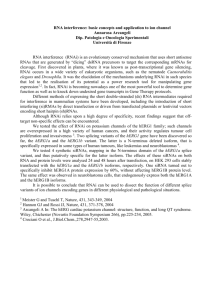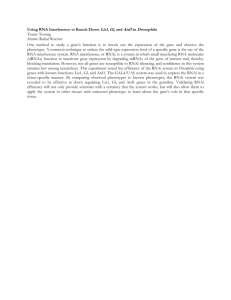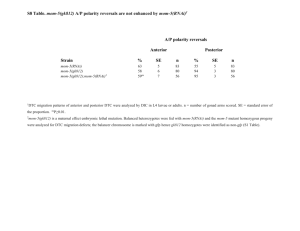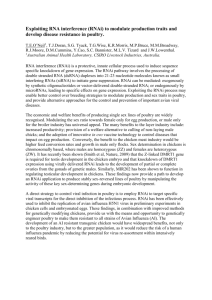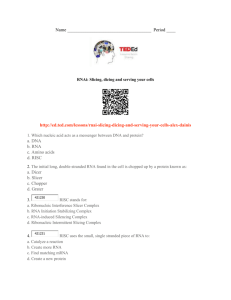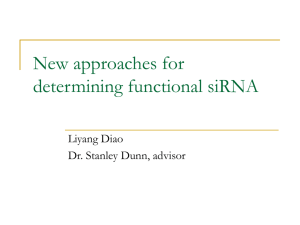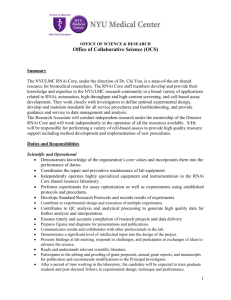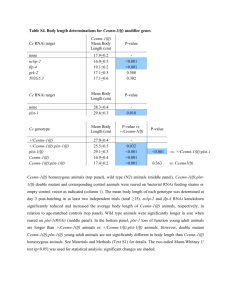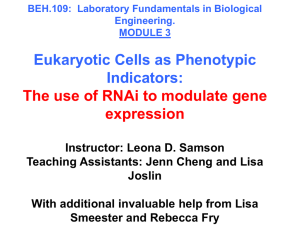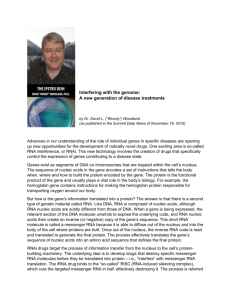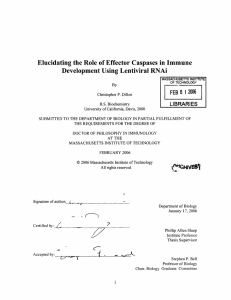September 22, 2015 Team 2 (Raquel Adams, Richi Gupta)
advertisement
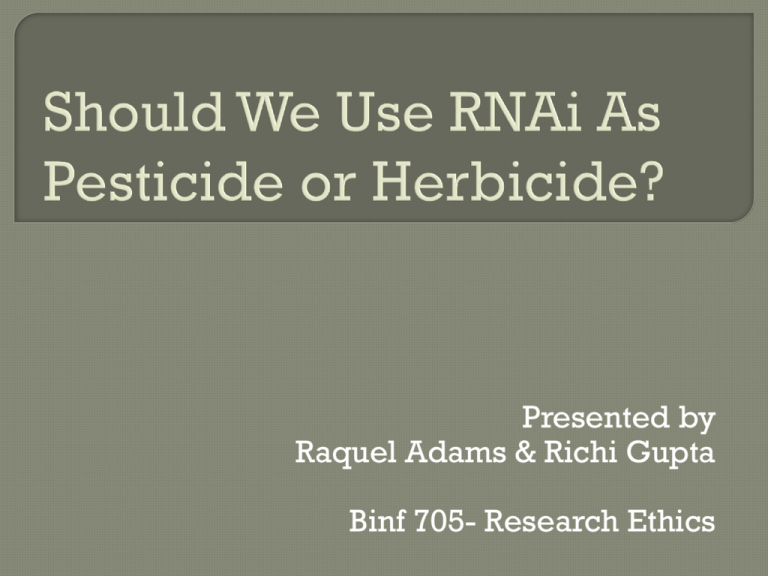
Presented by Raquel Adams & Richi Gupta Binf 705- Research Ethics Background and History of RNAi What is RNAi? • • • • Molecular mechanism siRNA vs miRNA Applications of RNAi Limitations of RNAi RNAi Beneficial or Harmful? Potential concerns EPA Laboratory Assay References In 1990,Nepoli and Jorgenson were first to report RNAi type phenomenon in Petunias. Named this phenomenon as “co-suppression” In 1990’s, other scientists also observed independently that RNA inhibited protein expression in plants and fungi. • Plants - post-transcriptional gene silencing (PTGS) • Fungi - quelling In 1998, Andrew Fire and Craig Mello discovered the phenomenon of RNA interference or RNAi. They awarded the 2006 Nobel price for Physiology or Medicine for their discovery. Set of related processes in which small regulatory RNAs direct sequence-specific repression of gene expression Evolutionary ancient and various versions are found in eukaryotic organisms. Some are induced by invasive nucleic acids (e.g. viruses, transposons, or transgenes, and serves to defend the host plant against such invaders) – short interfering RNA (siRNA) pathway. Some are endogenous pathways used to control an organism’s own gene expression- micro RNA (miRNA) pathway siRNA based approach • Hairpin transgenes or RNAi construct is designed to produce a population of dsRNA with complementarity to a chosen target messenger • Very effective at silencing the target gene as there are many different small RNAs all targeting the same transcript miRNA based approach • Endogenous miRNA gene is genetically engineered to produce a transgene in which the endogenous miRNA in the precursor is replaced with one that is complementary to the targeted messenger RNA • Precise, more selective as only one small RNA is produced rather than a population Examples of transgenic RNAi trait development • • • • • • • • • • Modified oil composition in soybean Increased lysine content in corn Reduced caffeine content in coffee Potato starch composition (e.g., Amflora) Reduced lignin alfalfa Reduced phytate sorghum Delayed softening in tomatoes Virus resistant plums, papaya, potatoes, squash, etc Nematode resistant soybean Target pest that feed on root-knot nematodes, corn rootworm, and bollworm Development of resistance Sequence heterogeneity of siRNA can cause off-target effects which can be overcome by miRNA approach siRNA-based RNAi strategies might not be suitable for some applications requiring tissue-specific silencing of genes miRNA-based RNAi gene silencing might not be very durable because only a single 21- or 22-nt specificity determinant is involved. 40 percent of food in the US today goes uneaten Reducing food losses by just 15 percent would be enough food to feed more than 25 million Americans every year Benefits? • How RNAi Pesticides and Herbicides work? • The case of Resistance Potential Hazards EPA Laboratory Assessments Could let farmers alter crops without permanent genetic modification. Ie: spray a crop with a drought remedy only when there’s a drought, control mosquitoes in an environmentally benign way Could save the honey bees? (neonicotinoid) Today, Monsanto has revenues of about $9 billion a year from GM seeds for crops that produce the insect toxin Bt or resist the weed killer Roundup. GM corn, soy, and cotton plants now spread across 180 million hectares. http://www.technologyreview.com/featur edstory/540136/the-next-great-gmodebate/ http://www.nytimes.com/2014/01/28/business/energy-environment/geneticweapon-against-insects-raises-hope-and-fear-in-farming.html?_r=0 Monsanto claims that insects won't likely develop resistance to the RNAi treatments, as they have to most chemical treatments in the past. "This is surprisingly reminiscent of Monsanto's assurancesin the '90s that weeds would be very unlikely to develop resistance to the glyphosate [Roundup] herbicide…and now we have an epidemic of glyphosate resistant weeds.” http://www.motherjones.com/tomphilpott/2015/08/coming-farm-fieldnear-you-gene-silencing-pesticidesRNA-RNAi BioDirect Insect Control: Colorado Potato Beetle (Phase II) BioDirect Bee Health: Aims to control Varroa mites and multiple viruses (Phase I) BioDirect Virus Control: Tospovirus Control –against the tomato spotted wilt virus. (Phase I) BioDirect Weed Control: Palmer Amaranth + Waterhemp (Phase I) Usually takes 9-10 years from Phase I of R&D. degrades quickly in soil genetically precise enough to kill potato bugs but spare their ladybug cousins. So far, consuming RNA molecules appears no more toxic to people than drinking a glass of orange juice. As Monsanto put it in a letter to U.S. regulators, “humans have been eating RNA as long as we have been eating.” http://www.technologyreview.com/featuredstory/54 0136/the-next-great-gmo-debate/ immune stimulation, saturation of the RNAi machinery off-target gene silencing, silencing the target gene in unintended organisms, Most of the cases will be presented via journals published. It was found that the injection of small fragments (fewer than 30 nt) of RNA could stimulate an immune reaction in mammals (Robbins et al. 2009) In mammals, the immunostimulation by RNAi led to reduced lymphocytes and platelet cells, largely correlated with cytokine response to the siRNA (Judge et al. 2005). Although there are some similarities in the innate immune response of insects and mammals, it is unclear how the immune systems of other organisms will react to an influx of small RNAs. Nor is it known how this immunostimulation will affect the fitness of nontarget organisms (Lundgren and Jurat-Fuentes 2012). Activation of the mammalian immune system by siRNAs Joao T Marques1 & Bryan R G Williams1 Most mammalian cells possess intracellular pathways that recognize dsRNA through cytoplasmic receptors, such as PKR, OAS and RIG-I. These pathways can also recognize siRNAs and activate IRF-3, NF-kappaB and MAPK pathways leading to the expression of IFN and pro-inflammatory cytokines. In addition, activation of PKR and OAS pathways results in general protein synthesis inhibition. In the cytoplasm the siRNAs also enter the RNAi pathway through RISC. RISC, RNA-induced silencing complex; IFN, interferon; PKR, dsRNA-dependent protein kinase; IRF, interferon regulatory factor; RIG-I, retinoic acid inducible protein; OAS, 2'5'-oligoadenylate synthetase. http://www.nature.com/nbt/journal/v23/n11/fig_tab/nbt1161_F2.html One in silico examination of sequence homologies between siRNA sequences and three transcriptomes from diverse organisms revealed that off- target effects were observed in as few as 5% and up to 80% of the siRNAs assessed (Qiu et al. 2005). 17% of siRNAs had complete sequence homologies with offtarget binding sites in the Drosophila melanogaster genome (Kulkarni et al. 2006). These studies indicate that off-target effects of siRNAs used in RNAi are probably more common than was initially believed; these effects could have implications for nontarget effects of GM crops if off-target gene suppression occurs in nontarget organisms and if these organisms are exposed to RNAi to a sufficient degree. High levels of exogenous siRNAs can saturate a cell’s RNAi machinery and thereby reduce the efficiency at which a cell regulates endogenous gene expression (Agrawal et al. 2003, Dillin 2003). There is a limited number of RISCs (RNAinducedd silencing complex) present within a cell, and if the augmented siRNAs saturate these complexes, the health and performance of the cell may be compromised (Kahn et al. 2009). In developing GM maize plants resistant to D. virgifera (spotted cucumber beetle). Baum and colleagues (2007) also examined the effects of a few of the dsRNAs identified for plant transformation on several other beetle species. dsRNAs that targeted D. virgifera (spotted cucumber beetle) also reduced survival of Diabrotica undecimpunctata (western corn rootworm) and Leptinotarsa decemlineata (Colorado potato beetle) significantly, even though these pests shared only 79% and 83% of their genome, respectively. A recent study showed that plant-produced microRNAs constitute 5%–10% of human microRNAs and that these are likely taken in with food (Zhang et al. 2012). Their work indicate that “ microRNAs taken into an animal through food may occur more often than is commonly thought and may influence gene expression in nontarget organisms that ingest siRNAs within plant tissues.” Dr. Vicki Vance, a biology professor at the University of South Carolina, found that dietary RNAs from plants could cross the gastrointestinal barrier and act as a potential cancer treatment. She publicly cautions on the use of RNAi as pesticides and Monsanto cancelled her scheduled address to an international symposium on the biosafety of GMO food products. She refuses to ignore her findings 1: Safe consumption of RNA - no convincing evidence in the literature that ingested dsRNA is absorbed from the mammalian gut in a form that produces biological effects. 2: RNA degradation in the mammalian digestive system - In the digestive tract and elsewhere, RNA is subject to both non-enzymatic and enzymatic degradation 3: Barriers to uptake and systemic distribution of dietary RNA in mammals vs. other organisms Mechanisms for exogenous dsRNA import into RNAi pathways are not known in mammals, and reports of carrierunmediated small RNA uptake await confirmation 4: Immune stimulation - that there is no clear evidence that small RNAs could trigger the immune systems of nonmammalian non-target species or what dose is necessary to trigger a response. Address nontarget species by administering a maximum-hazard dose (1–20 times the dose) of the known environmental exposure concentration. Focus on six to eight indicator species: honeybees, springtails, earthworms, daphnia, predatory beetles or pirate bugs, and parasitoid wasps They must represent different functional guilds (e.g., pollinators, predators, parasitoids, detriti- vores). PIPs – Plant-Incorporated Protectants "Big 6" pesticide and GMO corporations are BASF, Bayer, Dupont, Dow Chemical Company, Monsanto, and Syngenta. Companies working on RNAi sprays: • Monsanto • Syngenta recently acquired all of Devgen for around $500 million. • Bayer is also pursuing the research British writer George Monbiot: “The world has a surplus of food, but still people go hungry. They go hungry because they cannot afford to buy it. They cannot afford to buy it because the sources of wealth and the means of production have been captured and in some cases monopolized by landowners and corporations. The purpose of the biotech industry is to capture and monopolize the sources of wealth and the means of production … Agrawal N, Dasaradhi PVN, Mohmmed A, Malhotra P, Bhatnagar RK, Mukherjee SK. 2003. RNA interference: Biology, mechanism, and applications. Microbiology and Molecular Biology Reviews 67: 657–685. Davidson BL, McCray PB. 2011. Current prospects for RNA interference– based therapies. Nature Reviews Genetics 12: 329– 340. Dillin A. 2003. The specifics of small interfering RNA specificity. Proceedings of the National Academy of Sciences 100: 6289–6291. Jackson AL, Linsley PS. 2010. Recognizing and avoiding siRNA offtarget effects for target identification and therapeutic application. Nature Reviews Drug Discovery 9: 57–67. Judge AD, Sood V, Shaw JR, Fang D, McClintock K, MacLachlan I. 2005. Sequence-dependent stimulation of the mammalian innate immune response by synthetic siRNA. Nature Biotechnology 23: 457–462. Kahn AA, Betel D, Miller ML, Sander C, Leslie CS, Marks DS. 2009. Transfection of small RNAs globally perturbs gene regulation by endog- enous microRNAs. Nature Biotechnology 27: 549–555. Lundgren JG, Duan JJ. 2003. RNAi-Based Insecticidal Crops: Potential Effects on Nontarget Species. BioScience 8:657-665. Lundgren JG, Jurat-Fuentes JL. 2012. Physiology and ecology of host defense against microbial invaders. Pages 461–480 in Vega FE, Kaya HK, eds. Insect Pathology, 2nd ed. Academic Press. Qiu S, Adema CM, Lane T. 2005. A computational study of off-target effects of RNA interference. Nucleic Acids Research 33: 1834–1847. Robbins M, Judge A, MacLachlan I. 2009. siRNA and innate immunity. Oligonucleotides 19: 89–102. Zhang L, et al. 2012. Exogenous plant MIR168a specifically targets mam- malian LDLRAP1: Evidence of cross-kingdom regulation by microRNA. Cell Research 22: 107–126. FIFRA Scientific Advisory Panel Meeting Held at One Potomac Yard Arlington, Virginia . January 28, 2014. A Set of Scientific Issues Being Considered by the Environmental Protection Agency Regarding: RNAi Technology: Program Formulation for Human Health and Ecological Risk Assessment. SAP Minutes No. 2014-02. http://www.technologyreview.com/featuredstory/54 0136/the-next-great-gmo-debate/ http://www.motherjones.com/tomphilpott/2015/08/coming-farm-field-near-you-genesilencing-pesticides-RNA-RNAi
